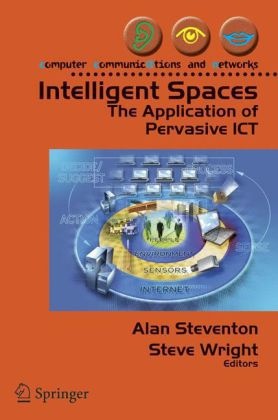En savoir plus
This book sets out a vision of intelligent spaces and describes the progress that has been made towards realisation. The context for Intelligent Spaces (or iSpaces) is the world where ICT (Information and Communication Technology) and sensor systems disappear as they become embedded into physical objects and the spaces in which we live, work and play. The ultimate vision is that this embedded technology provides us with intelligent and contextually relevant support, augmenting our lives and experience of the physical world in a benign and non-intrusive manner.
The ultimate vision is challenging, there are technical barriers, especially in the integration of complex systems and in the creation of intelligent software, as well as social and economic barriers.
This book explores what is technically possible and what users will need for the future. Academic and industrial researchers in Computer Science, IT and Communications, as well as practitioners will find this key reading as it delivers practical and implementable current research.
Table des matières
Intelligent Spaces.- The Socio-Economic Impact of Pervasive Computing.- No Pervasive Computing without Intelligent Systems. The Supply Chain.- Care in the Community.- Pervasive Home Environments.- Traffimatics.- Mixed Reality Application in Urban Environments.- A Sensor Network for Glaciers.- Cooperation in the Digital Age.- Maintaining Privacy in Pervasive Computing.- RFID Security and Privacy.- Ambient Technology.- Integrated Sensor Networks for Monitoring the Health and Well-being of Vulnerable Individuals.- Segmentation and Tracking of Multiple Moving Objects for Intelligent Video Analysis.- An Attention-based Approach to Content-based Image Retrieval.- Eye Tracking as a New Interface for Image Retrieval.- The Implications of Pervasive Computing on Network Design.- Autonomic Computing for Pervasive ICT.- Scale-Free Topology for Pervasive Networks.- NEXUS: Resilient Intelligent Middleware.- Intelligent Data Analysis for Detecting Behaviour Patterns in iSpaces.- xAssist: Inferring User Goals form Observed Actions.- Programming iSpaces.
A propos de l'auteur
Steve Wright has 17 years of experience in CGI and digital effects for broadcast television commercials, feature films, ride films, and IMAX films.
Résumé
This book sets out a vision ofpervasive IT through intelligent spaces and describes some ofthe progress that has been made towards its realisation. The context for intelligent spaces (or iSpaces) is the world where information and communication technology (lCT) disappears as it becomes embedded into physical objects and the spaces in which we live and work. The ultimate vision is that this embedded technology provides us with intelligent and contextually relevant support, augmenting our lives and our experience of the physical world in a benign and non intrusive manner. The enormous advances in hardware, system design, and software that are being achieved enable. this vision. In particular, the performance advances and cost reductions in hardware components - processors, memory, storage, and communications - are making it possible to embed intelligence and communications ability into lower cost objects. The Internet is a living experiment in building complex, distributed systems on aglobal scale. In software, there have been solid advances in creating systems that can deal with complexities on the scale required to interact with human activity, in limited domains at least. The ultimate vision is challenging, and there are many obstacles to its realisation.
Texte suppl.
Intelligent spaces : the application of pervasive ICT (Computer Communications
and Networks)
Steventon A., Wright S., Springer-Verlag New York, Inc., Secaucus, NJ, 2005. 438 pp.
Type: Book
Date Reviewed: Mar 16 2006
Information and communication technology (ICT) has been around for several years. It
improves the way we compute and communicate, and yet human lives have remained
essentially the same. However, this is about to change. As this book explains, every facet
of human endeavor will be affected and changed (for the better, we hope) by pervasive
ICT, referred to here as intelligent spaces (iSpaces).
The book consists of 24 chapters written by different authors. The topics can be roughly
divided into five parts. The first part introduces the basics of iSpaces: what they are, their
impact, and the science and technology needed behind them. The second part briefly
explains several applications of iSpaces, ranging from supply chain,home, and community
environment to the monitoring of highway traffic and glaciers. The third part discusses
trust, privacy, and security issues in iSpaces. The fourth part is oriented more toward
technology, discussing several implementations of iSpaces. The final part examines the
digital infrastructure that will need to be there in order for iSpaces to work. In general, this
book is well edited and each chapter is concise. However, 24 chapters are a lot to digest
and perhaps the fourth part could have been omitted without affecting the value of the
book too much.
The intended audience for this book is not clear. If meant for the general public, then the
authors could perhaps have focused more on the social impact and changes iSpaces will
bring. Color images would also help to engage readers.
One final question comes to mind: are iSpaces always good for people? Have any disasters
occurred in the past due to pervasive (or some may say invasive) ICT? A chapter or two
discussing real examples of the downside of iSpaces would help this book to be more
complete and insightful.

